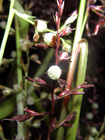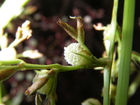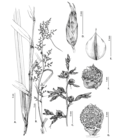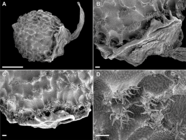Cyperaceae taxon details
Scleria nusbaumeri Bauters
1778801 (urn:lsid:marinespecies.org:taxname:1778801)
accepted
Species
recent only
Larridon, I.; Bauters, K.; Rasaminirina, F.; Díaz, J. G.; Márquez-Corro, J. I.; Gautier, L. (2024). A new remarkable species of <i>Scleria</i> (Cyperaceae) from northern Madagascar. <em>Candollea.</em> 79(1): 107-116., available online at https://doi.org/10.15553/c2024v791a6
page(s): 109 [details] Available for editors [request]
[request]
page(s): 109 [details] Available for editors
Holotype BR 00000256861, geounit Madagascar
Holotype BR 00000256861, geounit Madagascar [details]
Description Herb, perennial. Culm erect, trigonous, up to 200 cm long, 2–3 mm wide below inflorescence, up to 5 mm at its widest....
Etymology The new species is dedicated to Louis Nusbaumer, now curator at the Conservatoire et Jardin botaniques de Genève, who was...
Description Herb, perennial. Culm erect, trigonous, up to 200 cm long, 2–3 mm wide below inflorescence, up to 5 mm at its widest. Leaves up to 5; blades green and iridescent reflections when fresh, 36–50 cm long, 11–16 mm wide at widest point, glabrous; margins scabrous especially towards the apex; midrib slightly scabrous, pseudopraemorse with long acuminate tip of 10–26 cm. Sheaths winged; wings 2.3–3 mm wide, glabrous, scabrous on margins. Ligule absent or inconspicuous. Contraligule triangular with rounded tip, 3 mm long, 3 mm wide at base, lacking appendages, slightly pubescent. Inflorescence 35–50 cm long, with one panicle at each node; partial inflorescences densely paniculate; axes green at first, turning purplish red when fresh; primary bracts foliaceous, not pseudopraemorse, 13–31 cm long, 0.5–1.8 cm wide, glabrous, scabrous on margins, long acuminate tip. Staminate spikelets 3.5–5.2 mm long, red-brown; pedicel 3–4 mm long or sessile; staminate glumes 3–4.5 mm long, abruptly acuminate tip, sparsely pubescent, scabrous on midrib. Stamens 3; anthers (not seen). Subandrogynous spikelets 2.9–3.6 mm long; pistillate glumes 2.6–3.4 mm long, with slightly recurved acuminate tip, chestnut brown with dark purple midrib. Style (not seen). Nutlet globose–subglobose, 2.5 mm long (incl. hypogynium), 3 mm wide, body white (dried), undulate–rugose, with tufts of hair-like trichomes on the ridges, apex acuminate and smooth. Hypogynium inconspicuous, more or less trilobed, margins weakly laciniate. Cupule 3-lobed, remaining attached to the spikelet. [details]
Etymology The new species is dedicated to Louis Nusbaumer, now curator at the Conservatoire et Jardin botaniques de Genève, who was...
Etymology The new species is dedicated to Louis Nusbaumer, now curator at the Conservatoire et Jardin botaniques de Genève, who was conducting his PhD under the supervision of LG at the time of the discovery. Passionate in the field as well as in the herbarium, he is deeply involved in the research on and conservation of the Madagascan flora and vegetation, as well as in the training of Malagasy and foreign botanical students. [details]
Cyperaceae Working Group. (2025). [see How to cite]. Global Cyperaceae Database. Scleria nusbaumeri Bauters. Accessed at: https://cyperaceae.org/aphia.php?p=taxdetails&id=1778801 on 2025-09-11
Date
action
by
![]() The webpage text is licensed under a Creative Commons
Attribution 4.0 License
The webpage text is licensed under a Creative Commons
Attribution 4.0 License
Nomenclature
original description
Larridon, I.; Bauters, K.; Rasaminirina, F.; Díaz, J. G.; Márquez-Corro, J. I.; Gautier, L. (2024). A new remarkable species of <i>Scleria</i> (Cyperaceae) from northern Madagascar. <em>Candollea.</em> 79(1): 107-116., available online at https://doi.org/10.15553/c2024v791a6
page(s): 109 [details] Available for editors [request]
[request]
page(s): 109 [details] Available for editors
 Present
Present  Inaccurate
Inaccurate  Introduced: alien
Introduced: alien  Containing type locality
Containing type locality
Holotype BR 00000256861, geounit Madagascar [details]
Isotype G 00180755, geounit Madagascar [details]
Isotype K 001417494, geounit Madagascar [details]
Isotype MO, geounit Madagascar [details]
Isotype P, geounit Madagascar [details]
From editor or global species database
Description Herb, perennial. Culm erect, trigonous, up to 200 cm long, 2–3 mm wide below inflorescence, up to 5 mm at its widest. Leaves up to 5; blades green and iridescent reflections when fresh, 36–50 cm long, 11–16 mm wide at widest point, glabrous; margins scabrous especially towards the apex; midrib slightly scabrous, pseudopraemorse with long acuminate tip of 10–26 cm. Sheaths winged; wings 2.3–3 mm wide, glabrous, scabrous on margins. Ligule absent or inconspicuous. Contraligule triangular with rounded tip, 3 mm long, 3 mm wide at base, lacking appendages, slightly pubescent. Inflorescence 35–50 cm long, with one panicle at each node; partial inflorescences densely paniculate; axes green at first, turning purplish red when fresh; primary bracts foliaceous, not pseudopraemorse, 13–31 cm long, 0.5–1.8 cm wide, glabrous, scabrous on margins, long acuminate tip. Staminate spikelets 3.5–5.2 mm long, red-brown; pedicel 3–4 mm long or sessile; staminate glumes 3–4.5 mm long, abruptly acuminate tip, sparsely pubescent, scabrous on midrib. Stamens 3; anthers (not seen). Subandrogynous spikelets 2.9–3.6 mm long; pistillate glumes 2.6–3.4 mm long, with slightly recurved acuminate tip, chestnut brown with dark purple midrib. Style (not seen). Nutlet globose–subglobose, 2.5 mm long (incl. hypogynium), 3 mm wide, body white (dried), undulate–rugose, with tufts of hair-like trichomes on the ridges, apex acuminate and smooth. Hypogynium inconspicuous, more or less trilobed, margins weakly laciniate. Cupule 3-lobed, remaining attached to the spikelet. [details]Diagnosis Scleria nusbaumeri Bauters is clearly distinct morphologically from the other species of section Abortivae by having densely paniculate partial inflorescences; lateral panicles longer than the internodes; pistillate glumes with slightly recurved acuminate tip and nutlets with remarkable hair-like trichomes on the ridges. [details]
Etymology The new species is dedicated to Louis Nusbaumer, now curator at the Conservatoire et Jardin botaniques de Genève, who was conducting his PhD under the supervision of LG at the time of the discovery. Passionate in the field as well as in the herbarium, he is deeply involved in the research on and conservation of the Madagascan flora and vegetation, as well as in the training of Malagasy and foreign botanical students. [details]







